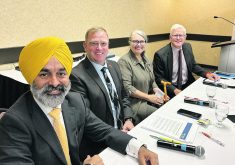Policy-makers and industry groups have proposed a list of possible solutions for the labour shortage in Canada’s agriculture sector:
- Encourage more young people to pursue a career in agriculture.
- Convince more retirees to continue working or try a second career in agriculture.
- Use automation to reduce the need for workers.
Those solutions may have merit, but Darcy Fitzgerald, executive director of Alberta Pork, believes the core solution is more immigration.
“The foreign worker is a big one. We need it. It doesn’t matter how anybody looks at it. Whatever the wording we use, we need workers to come here. This is how this country was built and how it’s going to be maintained,” Fitzgerald said.
Read Also

Research looks to control flea beetles with RNAi
A Vancouver agri-tech company wants to give canola growers another weapon in the never-ending battle against flea beetles.
“Agriculture, manufacturing, food services, retail — we’re at a loss without those new workers coming in from other countries…. For us to do anything, we need new people coming into this country on a continuous basis.”
Fitzgerald was responding to yet another report on the labour shortage in agriculture and the related risks to the country’s agricultural industry.
On Nov. 8, the Canadian Federation of Independent Business released a report called Help Wanted: Labour Shortages Threaten the Future of Canadian Agriculture.
The CFIB used existing data for its report but also surveyed its members in September to gather information on perceptions of the labour shortfall.
“Through data and insights coming directly from members … we highlight the experiences of small- and medium-sized agri-businesses that have been affected by chronic labour shortages which are exacerbated by other major issues … (like) rising carbon taxes and the growing burden of environmental regulations,” the report says.
The survey of small to mid-sized agri-businesses found:
- Nearly two-thirds (63 percent) of agri-businesses could not get all the staffing they needed.
- Ninety-five percent of agri-business owners have resorted to working more hours with 43 percent not finding it to be a useful solution to their labour problems.
Those numbers are based on CFIB surveys done in 2021 and earlier in 2022.
The CFIB member survey from September found similar results:
- Sixty-one percent of owners asked their employees to work more hours because of labour shortages.
- Forty-eight percent of agribusinesses have turned down sales or contracts because of a lack of workers.
Also concerning is the lack of optimism within agriculture.
Compared to other industries, such as manufacturing, construction and hospitality, agri-business owners have the least confidence in the future, the CFIB report said.
“Four in five agri-businesses say they would not advise someone to start a business because of labour shortages. This is concerning given the retiring population and lack of youth turning to agriculture for a career. We need to ensure agriculture is a viable career path for the next generation of farmers and agri-business professionals,” said Taylor Brown, senior policy analyst at CFIB.
Farmers and agri-business owners have tried to solve their labour shortfalls by offering higher wages, hiring temporary foreign workers, hiring retired workers and increasing the use of automation, the CFIB said.
Those strategies have worked in some cases, but many ag business owners are still desperate for a solution.
“It’s a mixed bag. You might have people who are very frustrated because they can’t find workers,” Fitzgerald said. “And you have others who have found workers, for whatever reason…. Maybe it’s (their) location.”
Geoff Propp, vice-president and general manager of Harvest Meats, which makes sausages, hot dogs, sliced meats and other products in Yorkton, Sask., said in September the company is short about 20 workers. Harvest Meats is expanding to fulfil strong demand for its products, so Propp may have to rely on the Temporary Foreign Worker Program to fill the vacant and new positions.
However, the paperwork and process of recruiting a temporary foreign worker from the Philippines, Central America and elsewhere is torturous. It can take six to nine months for the federal government to approve an application to hire one, and business owners must bear the cost and time of the program.
Propp said it’s absurd that businesses have to prove they can’t find a Canadian to do the job, when there’s nearly a million job vacancies in Canada.
In September, Statistics Canada reported 997,000 vacant positions in the second quarter of 2022, “the highest quarterly number on record.”
“Captain Obvious here: there’s more work in Canada than we have people to do the work,” Propp said.
“It’s time to open the floodgates. You can’t just bring in (immigrants or foreign workers) without some sort of vetting process, but to put that on businesses is not really helping.”
Fitzgerald agreed that immigration, as well as foreign workers, will be critical to solve the labour shortfalls within agriculture.
“I think the problem has always been the name of the program…. If it was an agricultural worker program, that would sound more positive,” he said.
“The phrase “temporary foreign workers,” somehow that has set off alarm bells with however politicians (view it) … (but) you’re not taking a job away from anybody because nobody is there (in Canada) to take the job.”


















